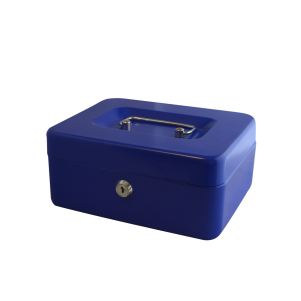Do cash boxes have keys or codes? understanding lock types
It is essential that a safe for securing valuables is a suitable design for your purposes. Anything that is impractical could lead to a serious security breach, whether you are securing valuables at home or in the workplace. A popular type of small safe is a cashbox, and it is important to understand what a cash box is and how it might be suitable for your needs. Factors to consider include the size and practicality of the cash box, but also how you intend to access it.
What is a cash box?
A cash box is a small type of portable safe made with robust sheet steel, and often used by a small business. The cash box can be opened using a hinged lid on the top of the cash box, and carried using a handle on this lid. Inside there is usually a removable tray insert which provides you with two layers. You can store coins on the top layer and use the underneath of the cash box – hidden from view by the tray insert – for storing larger volumes of cash notes, or other small valuables. A cash box is often used by a small business which works remotely, at festivals, fairs or in a market, or it might be used in an office for keeping and controlling petty cash. When not in use, the cash box is small enough that it can be locked away in a drawer or a larger, more robust safe.
How do you access a cash box?
The traditional way to access a cash box is using a key. The cash box supplied by MB Direct is supplied with two manual keys. These will enable you to access the lock and open the cash box as and when you need to. A key is simple to use and is reliable, however, a key can also be lost, stolen or copied. And if more than one person is using the cash box, always having access to the key can be a problem. A cash box is usually supplied with a spare key, but this is ideally kept safe in a separate location in case the original is lost. You don’t really want both keys in regular circulation.
Alternative ways to access a cash box
Using a small key to access a cash box works for most people, and is largely commensurate with the risk potential of the cash box, ie. because of its size it is only ever going to contain a relatively small amount of money or valuables. However, people like to have options and so there are other ways to access a cash box which all have their pros and cons.
Instead of using a traditional key, you can access the cash box using a four-digit code. This means a key can’t be lost, stolen or copied, but does mean you have to remember what the code is, and if several people need access to the cash box, the four-digit code becomes more widely known, perhaps too wide. In a simple cash box the code is usually inputted using a rotary dial. This is a metal dial with four adjacent rows of all the 0-9 digits, and the user has to line up the dials using the correct number sequence. Within the mechanism, the dials and gears line up as per the unique code and only enable access to the cash box if the correct sequence is found.
This is essentially the same system as with the rotary dial described above, but using a digital keypad. Instead of lining up the dials, a four-digit code or PIN number is tapped into a digital keypad on the front face of the cash box. This system has the same pros and cons as the rotary dial, except that a power source is required in order to power the digital system. This would normally be a battery, the performance and charge of which would need to be monitored, and the battery replaced as necessary. Whether you use a rotary dial or a digital cash box, it is relatively easy to change the unique number sequence, if there has been a security breach, or if you suspect there has been one. This will then foil the security threat and once again restrict who has knowledge of the correct code.
The final locking type commonly found with cash boxes is the use of a biometric feature. This is where a system is set-up so that a user presents a biometric feature – usually a fingerprint, face recognition or retina scan – and a sensor reads that scan, and if it is set-up as being acceptable, this will release the lock and enable access to the cashbox. This is the best security system as it can’t be stolen, copied or shared, and is very fast and convenient to operate, but is more commonly found with larger safes containing a bigger value than a cash box.
Choose the cash box locking type you prefer with MB Direct
Given the relatively small volume of cash and valuables it is possible to contain within a cash box, many people are satisfied with using a traditional key to access the lock. You can check out the cash box supplied by MB Direct and order today if it is suitable for your needs.